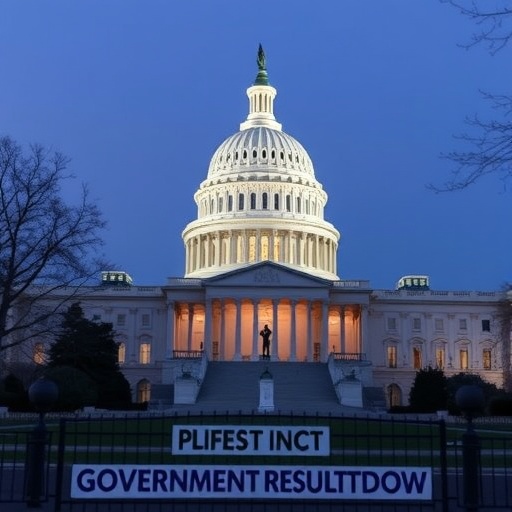U.S. Government shutdown Reaches Second-Longest Duration in History as Democrats and Republicans Deadlock Over Health Care Subsidies
In a stark reminder of Washington’s deepening divisions, the current Government shutdown has officially become the second-longest in U.S. history, surpassing the 21-day impasse of 1995-1996 and now stretching into its 22nd day. As federal agencies grind to a halt and essential services teeter on the brink, Treasury Secretary Scott Bessent issued a urgent plea to moderate Democratic senators to intervene, highlighting the escalating Congressional deadlock centered on pandemic-era health care subsidies set to expire at year’s end. This standoff between Democrats and Republicans threatens not only government operations but also the livelihoods of millions reliant on these vital supports.
- Treasury Secretary Bessent’s Direct Appeal to Moderate Democrats
- Deep Dive into the Health Care Subsidies Sparring Democrats and Republicans
- Historical Milestones: This Shutdown’s Place Among U.S. Impasses
- Rising Toll on Federal Workers, Economy, and Vulnerable Populations
- Potential Breakthroughs and Looming Deadlines Ahead
Treasury Secretary Bessent’s Direct Appeal to Moderate Democrats
Treasury Secretary Scott Bessent, a key figure in the Trump administration’s economic strategy, broke his relative silence on the crisis during a press briefing at the White House on Wednesday. “The time for partisan posturing is over,” Bessent declared, his voice carrying the weight of fiscal urgency. “I am calling on moderate Democratic senators—those who have shown a willingness to cross the aisle in the past—to step up and end this Government shutdown. The American people deserve better than this manufactured crisis.”
Bessent’s remarks were aimed squarely at senators like Joe Manchin of West Virginia and Kyrsten Sinema of Arizona, both known for their independent streaks and occasional bipartisan votes. He emphasized the economic ripple effects, noting that the shutdown has already cost the U.S. economy an estimated $1.2 billion per week in lost productivity, according to preliminary figures from the Congressional Budget Office (CBO). This includes furloughs for over 800,000 federal employees and delayed payments to contractors, many of whom are small businesses struggling in the post-pandemic recovery.
The secretary’s intervention comes amid reports of internal Republican frustrations. House Speaker Mike Johnson, R-La., has publicly supported Bessent’s call, stating in a floor speech, “We cannot let ideology blind us to the human cost. These health care subsidies were a lifeline during COVID-19; extending them shouldn’t be a battleground.” Yet, Democratic leaders, including Senate Majority Leader Chuck Schumer, dismissed the appeal as “political theater,” arguing that Republicans are using the shutdown as leverage to gut social programs.
Deep Dive into the Health Care Subsidies Sparring Democrats and Republicans
At the heart of this Congressional deadlock lies a fierce dispute over the enhanced health care subsidies introduced under the American Rescue Plan Act of 2021. These subsidies, which expanded Affordable Care Act (ACA) premium tax credits, have enabled millions of low- and middle-income Americans to afford health insurance amid skyrocketing medical costs. According to the Kaiser Family Foundation (KFF), enrollment in ACA marketplace plans has surged by 40% since the subsidies took effect, with over 21 million people now covered—a record high.
Originally designed as temporary measures to cushion the blow of the pandemic, these health care subsidies are slated to expire on December 31, 2025. Democrats, led by President Biden’s allies in Congress, are pushing for a permanent extension, estimating it would cost $250 billion over the next decade but prevent 4 million Americans from losing coverage. “This isn’t just about numbers; it’s about families who can’t choose between groceries and doctor visits,” said Sen. Elizabeth Warren, D-Mass., during a recent committee hearing.
Republicans, however, view the subsidies as an unsustainable expansion of government spending. House Republicans have proposed a phased reduction, tying any extension to broader fiscal reforms like cuts to Medicaid and work requirements for beneficiaries. “We’ve bailed out the economy once; it’s time to return to fiscal responsibility,” argued Rep. Kevin Brady, R-Texas, the ranking member of the House Ways and Means Committee. This partisan rift has stalled budget negotiations, with both sides accusing the other of holding the government hostage.
Historical data underscores the stakes. During the 2018-2019 shutdown—the longest on record at 35 days—the lapse in funding led to a 0.1% dip in GDP growth and increased food insecurity for federal workers. Experts warn that if the current government shutdown drags on, similar or worse effects could compound the ongoing inflation pressures, with the Federal Reserve projecting potential interest rate hikes to offset the uncertainty.
Historical Milestones: This Shutdown’s Place Among U.S. Impasses
The current government shutdown didn’t happen overnight; it’s the culmination of months of budgetary brinkmanship. Triggered on October 1 when Congress failed to pass a continuing resolution, the impasse has now eclipsed the 21-day shutdown under President Clinton in late 1995, which centered on welfare reform and spending cuts. That event, involving 800,000 furloughed workers, cost an estimated $1.4 billion and severely damaged Republican poll numbers.
Unlike past shutdowns driven by broader ideological battles—like the 2013 standoff over the ACA—this one is laser-focused on the health care subsidies. Yet, its longevity draws parallels to the 2018-2019 crisis, which stemmed from border wall funding disputes. Then, as now, the economic toll mounted quickly: national parks closed, IRS tax refunds delayed, and SNAP benefits for 40 million low-income Americans put at risk.
Statistics paint a grim picture. The U.S. Government Accountability Office (GAO) reports that shutdowns since 1976 have occurred 20 times, averaging 10 days each, but the trend toward longer durations is alarming. In this instance, non-essential services at agencies like the Department of Education and the Environmental Protection Agency (EPA) have halted, while essential workers—such as air traffic controllers and border patrol agents—continue without pay, accruing back wages that could total $11 billion if resolved soon.
Public sentiment is souring, too. A recent Pew Research Center poll shows 62% of Americans blaming both Democrats and Republicans equally for the Congressional deadlock, with approval ratings for Congress dipping to 18%. Veterans’ groups and labor unions have mobilized, with the American Federation of Government Employees (AFGE) organizing rallies in Washington, D.C., chanting, “Pay our workers, fund our future!”
Rising Toll on Federal Workers, Economy, and Vulnerable Populations
As the government shutdown wears on, its human and economic costs are becoming impossible to ignore. Federal employees, from park rangers in Yosemite to scientists at the National Institutes of Health (NIH), are facing unpaid bills and dipping into savings. “I’ve got two kids and a mortgage; this isn’t sustainable,” shared one anonymous IRS employee in a CNN interview. The Treasury Department estimates that 2.3 million civilian federal workers are affected, with many resorting to food banks or credit cards.
The broader economy feels the pinch as well. Wall Street analysts from Goldman Sachs predict a 0.2% contraction in fourth-quarter GDP if the shutdown extends beyond 30 days, exacerbating supply chain issues lingering from the pandemic. Small businesses dependent on federal contracts—numbering over 300,000—report delays in payments totaling $15 billion, per the Small Business Administration (SBA). In sectors like defense and agriculture, where government oversight is crucial, operations are stalling, leading to potential job losses estimated at 100,000 nationwide.
Vulnerable populations stand to suffer most from the health care subsidies debate. The Centers for Medicare & Medicaid Services (CMS) warns that without extension, premiums could rise by 75% for middle-class families, pricing out 3.5 million enrollees. Rural hospitals, already strained, could see a surge in uncompensated care, with the American Hospital Association projecting $50 billion in additional costs over five years. “This deadlock isn’t abstract; it’s a threat to public health,” said Dr. Ashish Jha, former White House COVID-19 response coordinator, in a op-ed for The New York Times.
Environmental and research impacts are equally dire. The EPA’s halted monitoring programs have delayed responses to wildfires and pollution alerts, while NIH grant reviews are frozen, stalling cancer and Alzheimer’s research funded by $40 billion annually. Immigration services, too, are backlogged, leaving asylum seekers in limbo and straining border communities.
Potential Breakthroughs and Looming Deadlines Ahead
With midterm elections on the horizon and the fiscal year ticking down, pressure is mounting for a resolution to this government shutdown. Bipartisan talks, mediated by the Senate Parliamentarian, are slated to resume next week, focusing on compromise language for the health care subsidies. Moderate Republicans like Sen. Susan Collins of Maine have signaled openness to a short-term extension, potentially buying time for comprehensive reforms.
President Biden, in a Rose Garden address, urged unity: “Democrats and Republicans must remember their oath to the Constitution. Let’s end this Congressional deadlock before it inflicts irreversible damage.” On the Republican side, former President Trump’s influence looms large; his social media posts have rallied the base against “socialist spending,” complicating negotiations.
Looking forward, analysts from the Brookings Institution suggest several paths: a clean continuing resolution to reopen government immediately, followed by targeted subsidy talks; or a debt ceiling linkage, tying resolution to broader tax reforms. Failure to act could trigger a credit rating downgrade, as warned by Moody’s Investors Service, spiking borrowing costs for everyone from homeowners to corporations.
As holiday seasons approach, the stakes couldn’t be higher. Families eyeing ACA open enrollment in November face uncertainty, and federal holiday travel could be disrupted by understaffed TSA screenings. Ultimately, whether through Bessent’s appeals or grassroots pressure, the end of this shutdown hinges on leaders prioritizing people over politics— a tall order in today’s polarized Capitol.








